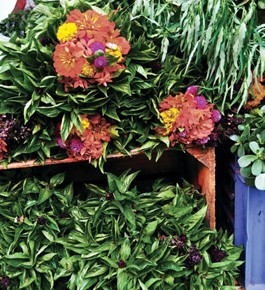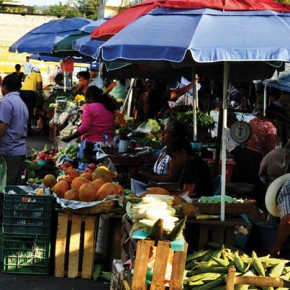Mexican markets can be crowded, loud, hot, and confusing. Shoppers expect low tarp ceilings, uneven floors, and obstructions. Unusual smells and noises are distracting while shoppers dodge dogs and toddlers underfoot. At first glance a market may appear overwhelming…
The seeming chaos is masking the underlying elegance of the Mexican market: a place to buy local fruits, eat a meal, discover regional art, and observe the beauty of the interactions between merchants and customers. Stepping inside a market in Mexico awakens the senses. Aromas of food being cooked, baked goods, meats and fish, fresh herbs and flowers flood fill the air. Noises collide together: jukeboxes and radios blaring music, blenders mixing cold drinks, and merchants selling products to their customers. The feeling of being inside a bustling market is difficult to describe, and well worth experiencing on a trip to Mexico.
Markets in Mexico vary in size and products offered:
Every city has at least one large market, and often hosts several smaller, specialty markets. In Pátzcuaro, Michoacán, the largest market spans several city blocks and includes stands selling fresh produce, household goods, crafts, meats, and small stalls selling food. In addition to the large market, Pátzcuaro and most cities have smaller weekly markets called tianguis, a weekly market. Some markets specialize in selling dried goods, clothing, or household objects. Markets are one of the treasures of Mexican culture, and are the best way to get good deals on local products.
Large markets usually have at least one section devoted to stands serving meals including regional specialties. In Oaxaca City, shoppers can snack on chapulines (grasshoppers) while admiring world-famous hand-woven rugs made in a village nearby.
In Morelia, the Mercado de Dulces (Sweet’s Market) is devoted to selling the candies of Michoacán. The fonda, or restaurant section of the market in Zihuatanejo, Guerrero, is filled with aromas of comida casera – home style cooked food. Menus include the daily guisado (stew), caldo de pollo (chicken soup), chiles rellenos (stuffed peppers), and all served with salsa and fresh corn tortillas. Other stands sell cold drinks, fresh squeezed juice, and agua fresca (ice water flavored with fruit or tea leaves and sugar).
Fresh fruit and vegetable stands occupy a large portion of a marketplace:
It is worth taking some time to see what fruits and vegetables are available, and try something new. Vendors will often offer a taste of exotic fruits to try, such as mamey, zapote, guayaba and cherimoya. For people who are traveling in Mexico and don’t have a kitchen to slice up a papaya, watermelon, or mango, some fruit stands sell cups of sliced fruit – served with optional chile, salt, and lime. Beet, carrot, orange and grapefruit juices are widely available and very inexpensive.
¿Habla Español?
Those who speak Spanish can take some time to learn the regional differences for the names of fruits and vegetables. In the Mexican highlands, asking a vendor for repollo will get you a cabbage. In Mexico City, asking for repollo will just get you a weird look since they use the more common term, col. If you are not sure what something is – ask! Vendors are more often than not friendly and happy to educate people about local foods especially if you shop at a time they are not too busy.
For those who don’t speak Spanish, shopping at a busy market can be daunting. Knowing a few key phrases will significantly improve your market shopping experience. If you have a phrasebook, bring it with you to the market. The vendors will usually appreciate that you are trying! Bring along a notebook and pen so that vendors can write down the prices if you do not understand numbers. Some people who don’t speak Spanish can visit the markets very early in the morning, before crowds pour in, to be able to take some time to find a vendor who speaks a bit of English or doesn’t mind Spanglish and sign language.
Prices
In some markets shoppers are expected to haggle over prices, but in others it will be considered rude. It is worth asking a local for advice on the appropriate way to shop. And when in doubt, shoppers should take their time to get a good feel of the prices to expect and the local customs and expectations for the behavior of tourists. It is important not to feel pressured to buy an item very quickly. Most large markets will have a few stalls that have prices labeled on the items, which can be very helpful for those who are unfamiliar with pesos and the goods being sold.
Tianguis
For locals, the vibrant tianguis is usually a favorite day of the week: a day to refresh the pantry, stock up on homemade cheeses and breads, and catch up on gossip with neighbors and friends. Mexico City hosts over 550 different tianguis! Merchants travel to the tianguis with fresh, mostly local produce. Vendors and locals know each other by first name and greetings are warm and frequent. The preferences of the locals are known by the vendors, who will remind their customers of special offerings.
Markets in Mexico offer a glimpse of the heart of Mexican community, food, cooking, and family. A visit to the marketplace is not only an opportunity to shop, but a chance to meet people, experience new flavors, and understand that purchasing a meal doesn’t have to start in a huge, sterile supermarket. Exploring the markets is an opportunity not to be missed!
- Bell, poblano, serrano and jalapeño peppers are just a few of the peppers readily available throughout Mexico. Photo by Marie Oaks.
- Beautiful and delicious fresh produce available daily. Photo by Marie Oaks.
- Beautiful and delicious fresh produce available daily. Photo by Marie Oaks.
- Basil, herbs and flowers. Photo by Marie Oaks.
- Small farmers’ market behind the mercado in Zihuatanejo. Photo by Marie Oaks.
- Pan Dulce (Sweet Breads). Photo by Marie Oaks.










